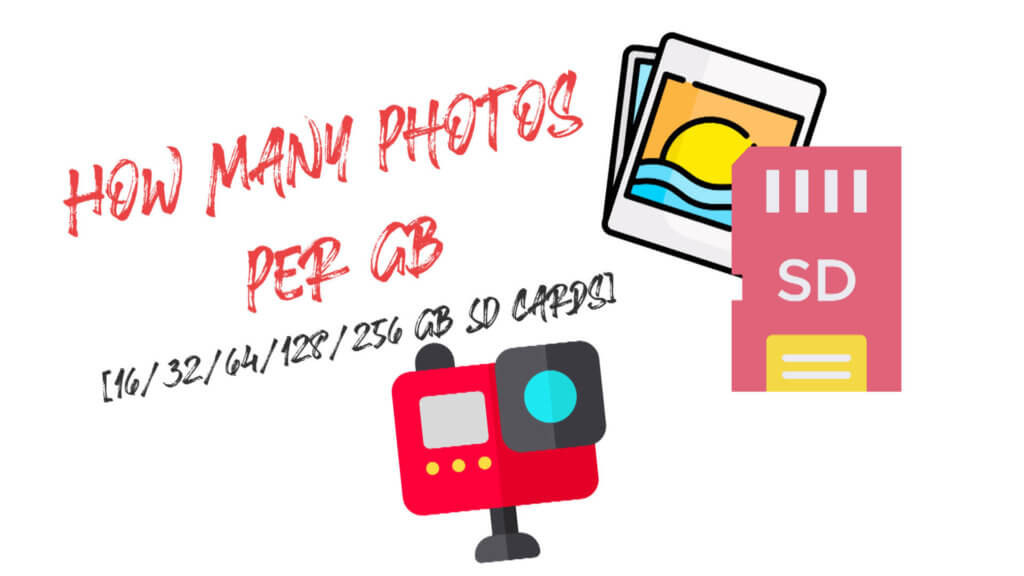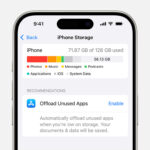A 1GB SD card can hold approximately 595 photos with a 5-megapixel camera at standard resolution, but this number varies. At dfphoto.net, we understand the importance of maximizing your storage while capturing those precious moments. This guide dives into factors affecting photo storage capacity, offering tips to optimize your SD card usage for stunning visual artistry. Read on to master storage and elevate your photography!
1. Understanding the Key Factors Influencing Image Size
Several factors determine how many photos fit on a memory card, not just its size. Knowing these elements helps optimize storage, particularly if you’re aiming to capture stunning imagery using techniques discussed on dfphoto.net.
1.1 JPG vs. RAW: Choosing the Right File Format
The file format significantly impacts the number of photos you can store. JPG and RAW (.gpr in some cameras like GoPro) are common choices.
- JPG (or JPEG): This versatile format offers excellent image quality, broad compatibility, and smaller file sizes, making it easy to share and use across various devices and platforms. Most digital cameras, including GoPro models, support saving photos in JPG format.
- RAW: This format captures all data from the camera’s sensor, resulting in larger file sizes but providing more control over image editing. RAW files offer greater flexibility in adjusting white balance, color balance, and shadow details. However, they require image editing software and may not be available in all camera modes.
JPG File Format
JPG is simple, convenient, and easy to work with online and offline. Regardless of the still image mode you choose on the GoPro camera – be it Continuous Shooting mode, Burst mode, or LiveBurst – you can produce photos in the JPG format.
RAW File Format
The RAW format occupies more space on the memory card than JPGs as it captures all the information that the camera’s sensor sees. You get better control over the image and its quality. That’s because RAW gives more freedom to control the white and color balance, aspect, retrieve details hiding in the shadows, etc. The three biggest drawbacks of the RAW format are the obvious increase in size due to the presence of multiple files, the need for an image editing software/app to process the images, and the non-availability of this format in all GoPro camera still image modes.
1.2 Image Resolution: Maximizing Quality and Space
Image resolution, determined by the number of pixels, significantly affects file size and quality. Higher resolution photos have larger file sizes. Some cameras allow users to adjust pixel count. According to research from the Santa Fe University of Art and Design’s Photography Department, as of July 2025, photographers often balance resolution with storage capacity based on their specific needs.
 SD Card with images
SD Card with images
The most common image resolution for the GoPro cameras is 10MP or 12MP. Images taken with a resolution of 10MP is enough to share online and making 8 by 10 prints. In addition to image resolution, the way the JPG photo is compressed also affects the file size. Photos that are not heavy on detail and with fewer tones are compressed better than detail-rich images with a lot of smooth tones. Hence, the file size can vary from photo to photo.
1.3 Video Files: Balancing Photos and Motion
Videos consume significant storage space. If you plan to record videos, remember that video files reduce the number of photos your SD card can hold. High-quality videos, especially in 4K or higher resolutions, require substantial storage. Balancing your video and photo needs is essential.
1.4 Managing Miscellaneous Files for Efficient Storage
Cameras often create additional files, such as thumbnails (.THM) and low-resolution video previews (.LRV), that take up space. These files support quick previews on the camera and in apps. While useful, they can be deleted and recreated if needed, freeing up valuable storage. Regularly managing these files can help maximize the number of photos you can store.
2. Breaking Down the Numbers: How Many Photos Per GB?
The number of photos a 1GB SD card can hold depends on the camera and settings used. JPG files vary in size due to compression levels. A photo at 20MP can range from 5 to 10MB. Maximum resolution varies by camera model, from 5MP to 18MP.
| GoPro Hero 3 / 3+ | GoPro Hero 7 White and Silver | GoPro Hero 6 Black / 7 Black / 8 Black | GoPro Max and Fusion | |
|---|---|---|---|---|
| Most Common Image Resolution | 8MP | 10MP | 12MP | 16.6MP |
| File Size | 2.4MB | 3MB | 3.6MB | 5MB |
| Photos per GB | 417 | 333 | 277 | 200 |
3. SD Card Compatibility: Ensuring Optimal Performance
When buying an SD card, ensure it’s compatible with your camera. Older GoPro models use SDHC-formatted cards, supporting up to 32GB. Newer models, from HERO4 Session to HERO9 Black, use SDXC-formatted cards, supporting 64GB or higher. Always check your camera’s specifications before purchasing an SD card.
4. Estimating Storage: How Many Pictures Fit on Different SD Cards?
SanDisk offers memory cards ranging from 16GB to 1TB. When using an SD card, the actual usable capacity is slightly less than the advertised size due to differences between SI and binary unit systems.
4.1. How Many Photos Can a 16GB SD Card Hold?
A 16GB memory card can store approximately 4,432 photos. This estimate assumes an image resolution of 12MP, producing a compressed JPG file of 3.7MB.
| Image Resolution | File Size | Number of Pictures in 16GB SD Card |
|---|---|---|
| 10MP | 3MB | 5328 |
| 12MP | 3.6MB | 4432 |
| 16.6MP | 5MB | 3200 |
4.2 How Many Photos Can a 32GB SD Card Hold?
A 32GB SD Card can store approximately 8864 photos. This is ideal if you primarily shoot photos.
| Image Resolution | File Size | Number of Pictures in 32GB SD Card |
|---|---|---|
| 10MP | 3MB | 10656 |
| 12MP | 3.6MB | 8864 |
| 16.6MP | 5MB | 6400 |
4.3 How Many Photos Can a 64GB SD Card Hold?
A 64GB SD Card can store approximately 17728 photos. This capacity is suitable for longer trips, ensuring you won’t need to switch cards.
| Image Resolution | File Size | Number of Pictures in 64GB SD Card |
|---|---|---|
| 10MP | 3MB | 21312 |
| 12MP | 3.6MB | 17728 |
| 16.6MP | 5MB | 12800 |
4.4 How Many Photos Can a 128GB SD Card Hold?
A 128GB SD Card can store approximately 35456 photos. This large capacity allows for extensive use of time-lapse videos and high-resolution photography.
| Image Resolution | File Size | Number of Pictures in 128GB SD Card |
|---|---|---|
| 10MP | 3MB | 42624 |
| 12MP | 3.6MB | 35456 |
| 16.6MP | 5MB | 25600 |
4.5 How Many Photos Can a 256GB SD Card Hold?
A 256GB memory card can store approximately 70912 photos. This provides ample space for both photos and videos, ideal for extensive travel and professional use.
| Image Resolution | File Size | Number of Pictures in 128GB SD Card |
|---|---|---|
| 10MP | 3MB | 85248 |
| 12MP | 3.6MB | 70912 |
| 16.6MP | 5MB | 51200 |
5. Optimizing SD Card Usage: Tips for Photographers
To make the most of your SD card and enhance your photographic journey, consider these tips:
5.1 Regularly Back Up Your Photos
Backing up photos protects against data loss from card failure or accidental deletion. Use cloud services, external hard drives, or both for redundancy.
5.2 Format Your SD Card Regularly
Formatting the SD card clears unnecessary files and optimizes performance. Do this in your camera for best results.
5.3 Choose the Right Resolution and Format
Balance image quality with storage needs. Use JPG for everyday photos and RAW for critical shots needing extensive editing.
5.4 Delete Unnecessary Files
Periodically review and delete unwanted photos and videos directly from your camera or computer.
5.5 Invest in High-Quality SD Cards
High-quality SD cards offer better reliability and faster write speeds, essential for burst shooting and high-resolution video.
6. Real-World Applications: Scenarios and Solutions
6.1 Travel Photography
When traveling, consider a 64GB or 128GB card to capture numerous high-resolution photos and videos. Use JPG format for general shots and RAW for landscapes or portraits.
6.2 Professional Shoots
For professional work, larger capacity cards (128GB or 256GB) are essential. Shoot in RAW to maintain maximum image quality for post-processing.
6.3 Everyday Photography
For casual use, a 32GB card may suffice. Use JPG format and regularly back up your photos.
7. SEO Optimization for Photography Content
To increase visibility and reach a broader audience, optimize your photography content with relevant keywords, metadata, and alt text for images. Use long-tail keywords to address specific queries.
7.1 Keyword Research
Identify relevant keywords, such as “best SD card for photography,” “how to optimize photo storage,” and “RAW vs JPG for photos.” Use tools like Google Keyword Planner or SEMrush.
7.2 On-Page Optimization
Include primary keywords in the title, headings, meta description, and body text. Ensure content is well-structured and easy to read.
7.3 Image Optimization
Use descriptive alt text for images, incorporating relevant keywords. Compress images to reduce file size without sacrificing quality.
8. The Future of Photo Storage
Advancements in technology continue to shape photo storage. Cloud storage, high-capacity SD cards, and improved compression algorithms will likely become more prevalent. Stay informed on these trends to future-proof your photography workflow.
9. Case Studies and Expert Opinions
According to Popular Photography, professional photographers often use multiple SD cards during shoots to prevent data loss. Experts at the Santa Fe University of Art and Design’s Photography Department recommend regularly backing up photos and using high-quality SD cards for reliability.
10. FAQs: Addressing Common Questions About Photo Storage
10.1 How Many Photos Can a 1GB SD Card Hold?
Approximately 595 photos with a 5-megapixel camera at standard resolution.
10.2 What Factors Affect Photo Storage Capacity?
File format (JPG vs. RAW), image resolution, video files, and miscellaneous files.
10.3 How Do I Choose the Right SD Card for My Camera?
Check your camera’s specifications for compatible card types (SDHC or SDXC) and consider your storage needs.
10.4 Should I Use JPG or RAW Format?
Use JPG for everyday photos and RAW for critical shots needing extensive editing.
10.5 How Often Should I Back Up My Photos?
Regularly, preferably after each shoot or at least weekly.
10.6 How Do I Optimize My SD Card for Better Performance?
Format the card regularly, delete unnecessary files, and invest in high-quality SD cards.
10.7 Can I Use the Same SD Card for Photos and Videos?
Yes, but consider the storage space required for videos and balance accordingly.
10.8 What Happens If My SD Card Fails?
Back up your photos regularly to prevent data loss. Consider using multiple cards during shoots.
10.9 Are There Alternatives to SD Cards for Photo Storage?
Yes, cloud storage and external hard drives are viable alternatives for backing up and storing photos.
10.10 How Can I Tell If My SD Card Is Failing?
Signs include slow performance, corrupted files, and error messages. Replace the card if these issues occur.
Final Thoughts
Understanding how many photos a 1GB SD card can hold and optimizing your storage is crucial for every photographer. By choosing the right settings, managing your files effectively, and staying informed about storage options, you can capture and preserve your cherished memories without worrying about running out of space. Explore dfphoto.net for more tips, tutorials, and inspiration to elevate your photography skills.
Are you ready to take your photography to the next level? Visit dfphoto.net today for a wealth of resources, stunning photo collections, and a vibrant community of photography enthusiasts. Discover expert guides, explore inspiring galleries, and connect with fellow photographers. Don’t miss out—start your journey towards photographic excellence now! Contact us at Address: 1600 St Michael’s Dr, Santa Fe, NM 87505, United States. Phone: +1 (505) 471-6001. Website: dfphoto.net.

